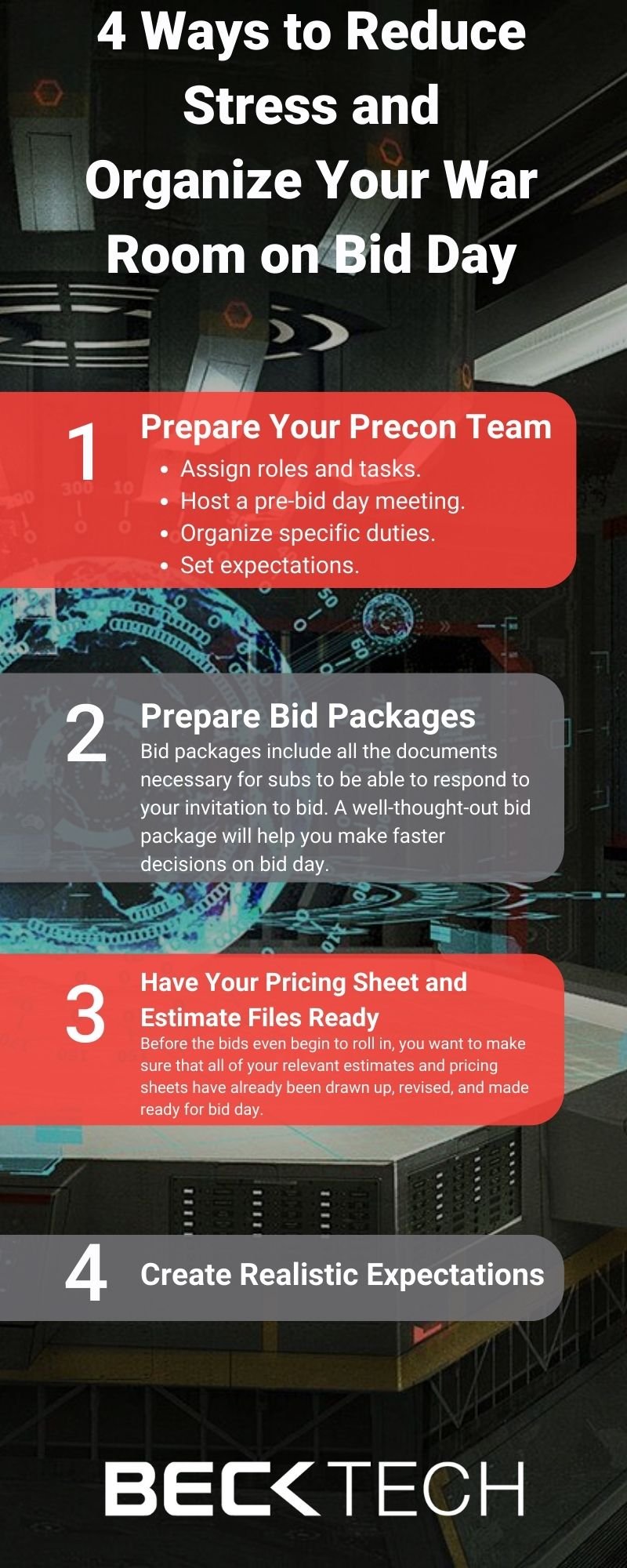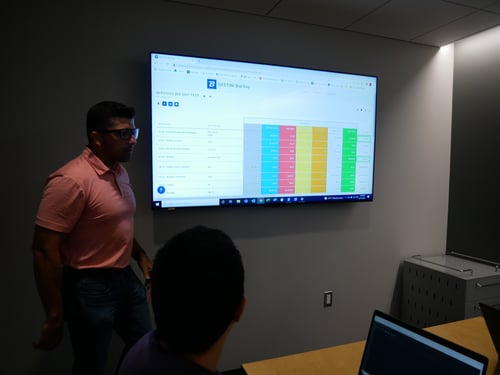How to Organize Your War Room on Bid Day
Overwhelmed by bid day?
Uncover four takeaways to help you reduce stress during an important part of the estimating process.
Bid day is without a doubt one of the most stressful parts of an estimator's job. It can be so hectic and intense that game day and high stakes gambling analogies are used to describe it. With so many calls, documents, and data coming in, it's critical to divide up your preconstruction team so that everything moves as efficiently as possible. Some even call the conference rooms where bid day takes place "the war room."
Part of what can make bid day so tricky is that it's difficult to know where to begin to organize your team's war room. That's why we spoke to our experts at Willis Smith Construction to come up with several tips for heading into bid day prepared and ready to go.
The Problem
One of the biggest reasons why bid day is so stressful is that it relies on everyone to be organized, synchronized, and timely. Chaos is created when the calls start, clarifying questions come in, gaps in scope are found, and the multitude of other items that happen during bid day seem to all come cashing in at one time.
While every bid day starts with good intentions, the fact of the matter is the same problems come up each time. Part of the issue is human nature to react in the moment to the stressors caused by the chaos and just focus on getting the job done instead of thinking ahead of the game and reorganizing bid day to be as efficient as possible. At some point, you throw your hands up in the air and succumb to "just get the job done".
Most estimators at the end of their bid day are completely wiped out mentally and physically. And the chaos created from the day can lead to resentment towards the process, the project, and/or the company. You hope the right information and subcontractors are accounted for and submitted correctly. Your nerves on edge and you are relieved you survived another bid day.

4 Ways to Reduce Stress and Prepare Your War Room
If this sounds overwhelming, don't worry. There are four important things you can do to prepare your bid day "war room" so that you're able to function as efficiently and accurately as possible.
- Prepare your precon team.
- Prepare bid packages.
- Create a preliminary construction schedule.
- Create realistic expectations.
Prepare Your Precon Team
Hosting a pre-bid day meeting and getting your team on the same page is ideal. Assigning roles and tasks ahead of the day gives the team direction coming into the actual day. You can prep accordingly and create organization for their specific duties. You can also help set expectations as well as point out any gaps in the bid day effort before the day arrives.
Additionally, identifying who is on the bid day team also means identifying who is NOT on the bid day team. Minimizing the distractions should be a priority and limiting the number of people in your war room will benefit your efforts.
Prepare Bid Packages
Robbie Gronbach, LEED AP and Director of Preconstruction at Willis Smith notes that before his team selects subs, "we'll put together some instructions as well as bid packages."
Bid packages include all of the documents that will be necessary for subs to be able to respond to your invitation to bid. It's important not to forget visual components here: drawings will be a huge asset to the subs you've invited. A well-thought-out bid package can also help you make faster decisions as to whom to move forward with and whom to turn down when you field incoming submissions on bid day.
Just as important, bid packages can keep your team organized if you have multiple projects to submit bids for. Accidentally sending the wrong quotes can throw you off balance and leave you struggling to get caught back up.
Have Your Pricing Sheet and Estimate Files Ready
Before the bids even begin to roll in, you want to make sure that all of your relevant estimates and pricing sheets have already been drawn up, revised, and made ready for bid day. Robbie says: "We want a complete division breakdown of all the applicable disciplines. We use tabs, and for our [Willis Smith's] hard bids, we just use one tab, and break it down by rows, so there are sections for each discipline." Once your estimates are ready to go, it'll be easier for you to plug in numbers and start asking subcontractors clarifying questions.
In addition to having your estimates prepped and ready to go, you'll also want to be sure to have numbers prepared for items that subs may not send any bids for. Don't forget to separately list any appropriate items that might be subject to exclusion by subcontractors.
Lastly, be sure to carefully review your estimates and pricing sheet prior to bid day. This will help you get a better picture of the scope of work and determine if a subcontractor is truly giving you an ideal, comprehensive bid, as well as helping you confirm acceptable exclusions.
Create Realistic Expectations
Thriving in chaos is the name of the game on bid day. Whether your project is hard bid or negotiated, stress is abundant. Let’s break down the expectations for both hard bid and GMP estimates to help set some realistic expectations.
Hard Bid Estimates
Hard bid models are favored by project owners for one major reason: project owners believe that the competition between contractors will give them the best possible price. And that might seem like the case at first glance. Because most of the contractors invited to the bid will all have access to the same construction documents and will likely invite a lot of the same subs, there is little that differentiates them from one another. The one thing that can help them stand out? A lower price.
On the plus side of a hard bid estimate, the project owner set the deadline for when the estimate is due, and your subs know that deadline. Having that external driver for submitting your bid does relieve some headaches but it is still a time crunch.
On the downside of hard bids, you know the lowest cost is going to win out and you may get a sub bid in with a few minutes left before your deadline. Therefore, you don’t have the time to review each detail of the bid and you are submitting the estimate with your fingers crossed that the entire scope of work was accounted for without a wayward cost associated with it. And in the back of your mind, you are already foreshadowing conversations around change orders. Which definitely leads to unpleasant conversations with the project owner and the buildup of stress starts again!
GMP Estimates
In a negotiated bid model, a general contractor is being asked to look at the design, consider alternates, approach the project as a problem solver, and is being tasked as a collaborator. It gives you greater flexibility to look at all angles of the project and be able to submit an estimate with better insight. As Robbie puts it: "[We're] trying to give [the client] the best bottom line and the most complete scope."
On the plus side of negotiated bids, you are setting your own deadline for when subcontractors need to submit their bids. (This is also a frustration, but we will dig into that next.) If your project owner needs your estimate submission by next Wednesday, you can set your deadline with subs for this Thursday, so you have time to review each submission and scope of work. You can catch gaps in estimates and follow up with your subcontractors to get clarity.
The negative side of negotiated bids related to bid day, you are living in that estimate longer than if it were a hard bid. Yes, negotiated work is more ideal because project owners do not necessarily pick the lowest price because they are looking for a team member who collaborates. However, the stress still builds up because leading up to (and after) the submission of your estimate you still wrack your brain over if you included everything needed for the project. Your “bid day” may be more like your “bid week”.
Don't Forget About Your Tools
While we hope that these four tips give you an idea for how to prepare for your next bid day, we also want to remind you that you're never fully prepared if you don't have the right tools. Being able to automate all of the bids you're receiving and filter them through different views is both a major stress-reliever and time-saver.
If you're interested in learning more about technology that can do all of the above, we encourage you to talk to our technical experts about DESTINI Bid Day here.

-1.png?width=112&height=112&name=image%20(4)-1.png)















